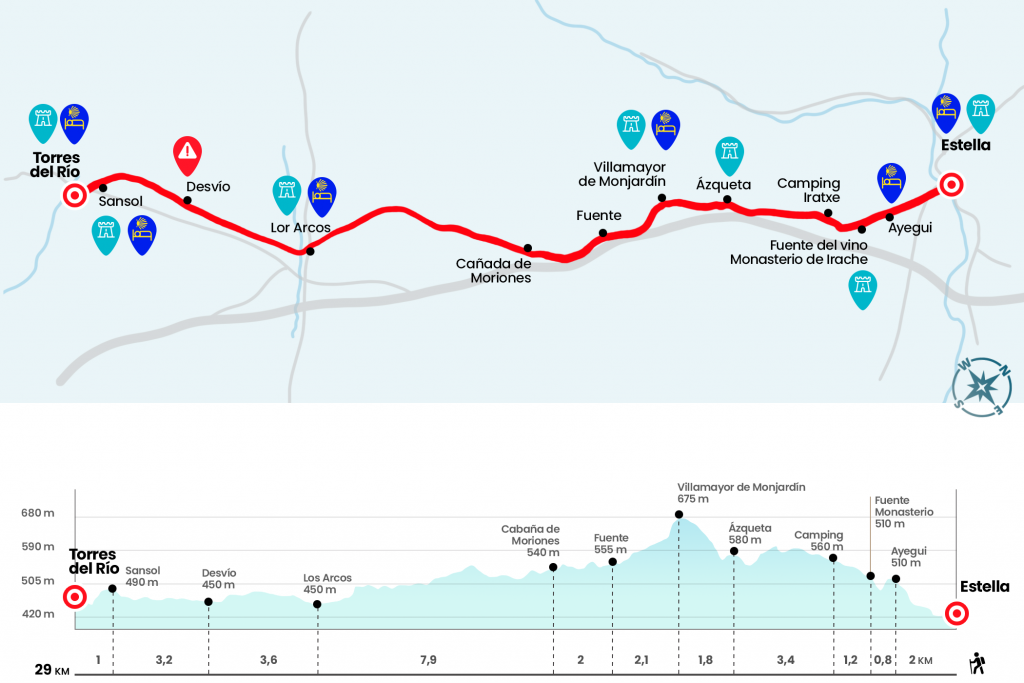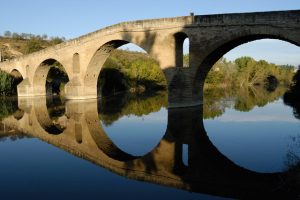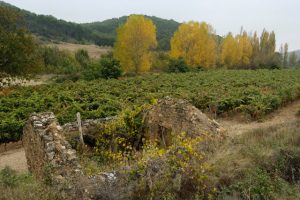Article translated by an automatic translation system. Press here for further information.
Estella/Lizarra to Torres del Río Stage
From Irache Monastery to the Arcos there are no villages
Information about the stage 6: Estella/Lizarra to Torres del Río Stage

Enlarge map
Points of interest in the stage 6: Estella/Lizarra to Torres del Río Stage
The route
- Km 0. Estella (All Services)
From the front, through the streets La Rúa, San Nicolás and Camino de Logroño, we departed through the corners that gave life to Estella, populated by francs thanks to the Fuero granted by King Sancho Ramírez in 1090. Between Rúa and San Nicolás, we find on one side the 12th century Palace of the Kings of Navarra and porticated facade, and on the other the modern staircase leading to San Pedro de la Rúa, a church of beautiful front and better cloister that seems to overcome the laws of gravity. He goes out to Zalatambor Street and we continue in front of the roundabout. After the gas station we diverted slightly to the right and continued to Ayegui, a former ecclesiastical lordship owned by his own town hall and physically assembled with Estella.
- Km 2. Ayegui (Hostel. Bars. Store. Pharmacy. ATM)
The traditional route descends to the fountain of Wine and Irache Monastery. The pile flows water and also came since 1991 and allows to cool off before reaching the cenobium of Irache, located under Montejurra. It is from the 11th century and brings together all possible styles although today it is uninhabited. When we leave it behind we reach a point where two options are presented: the first, more woody and front, goes along the slopes of Montejurra and passes through Luquin; the second, on the right, is the traditional and visit Azqueta and Villamayor de Monjardin. Both variants come together before Los Arcos.
We chose the traditional one, which leads us to cross the N-111 and transit through a service vial between the Camping Iratxe and the urbanization of the same name (Km 4). A tunnel gives access to a road surrounded by labor grounds that later penetrates between tight carrascas masses. The path is smoothly aborted to cross the road of Igúzquiza but we join it again and continue to Ázqueta, where Pablo Sanz Zudaire lives, nicknamed Pablito the de las Varas. Mythical on the Camino, Pablito builds and offers from 1986 strands of avellano to pilgrims who come to his house.
- Km 7.4. Bar. Host)
Who knows if with a new bourbon we leave Azzqueta and, after a few ships, turn left to win the departure to the gap between vineyards. On the edge of the road there is a medieval aljibe known by the source of the Moors, designed to satisfy the medieval pilgrims. Later on is Villamayor de Monjardin.
- Km 9.2. Villamayor de Monjardín (Hostels. Store. Bar)
Above, at the summit of the Monjardin, there are the remains of the castle of San Esteban de Deyo. In the town stands the church of San Andrés, Romanesque of the 12th century and with a baroque tower of the 18th century. It was restored between 1973 and 1984 and its greatest treasure is an old silver processional cross that already has a replica in the cathedral of the Polish locality of Torun. Villamayor is also famous for its winery and it is its own vineyards that guide us through the valley that was once known as San Esteban de la Solana. Two kilometers later we arrived at the junction of the Urbiola Road, with a source to hydrate us well and cope with the next ten kilometers without intermediate populations, through long and monotonous routes of concentration (Km 11,3). However, a couple of kilometers away we will find in season the Eduardo bar-trailer. Works since April 2014, opens in season (telf: 606 851 231) and serves cold drinks, hot bowls and combined dishes. A few texts by R. Ábrego animates this solitary section. In a panel, one of them informs us that in a nearby place, in 1873, Liberal General Domingo Moriones and his army were defeated by the Carlists (Km 13,3).
An hour and a half later we entered Los Arcos by the site of San Vicente and Calle Mayor. The people retain much of their historical legacy and the old pilgrim hospitals of Santa Maria, Santa Brígida and San Lázaro have passed the witness to a good number of more modern hostels. It is reached to the porticada square of Santa Maria where the church of the same name is located, a monumental building in which they meet from the late Romanesque to the baroque. The plaza invites the rest, deserved and necessary to face the final stage.
- Km 21.2. Los Arcos (All Services)
We passed the portal of Castile and immediately crossed the road and the river Odrón. After the last houses of Los Arcos we return to another agricultural track that advances in a straight line, parallel to the N-111, for three kilometers. At this point, difficult to describe but signposted, we turned right by a path (Km 24,8). We continue through it to the race of San Pedro and the road of Sansol, which leads us to this town.
- Km 28. Sansol (Hostel. Casa Rural. Bar. Pharmacy)
We leave Sansol next to a villa, already in view of Torres del Río. A rapid descent puts us at the gates of this population. It costs to climb through its steep streets and give with the church of the Holy Sepulchre, an octagonal temple of the 12th century that maintains a terraced tower that could be used as a beacon to guide the pilgrims who preceded us.
- Km 29. Torres del Río (Hostels. Bar. Store. ATM)
The difficulties
Remarks
In images
What to see, what to do
The hostels

¿Do you want to send any photo of "The Camino de Santiago"?
If you have any photos of "El Camino de Santiago" that you want to share with us, you can send them to us and enlarge the photo gallery


Forum: What pilgrims think about the Camino de Santiago
See all